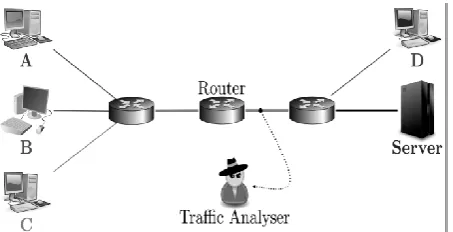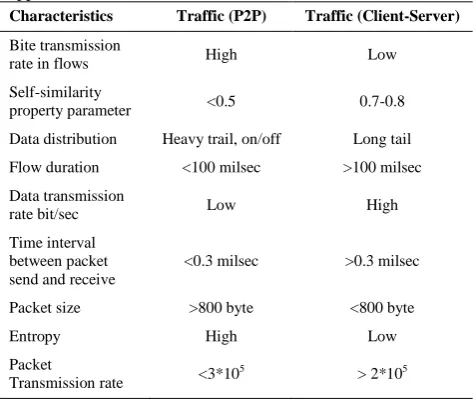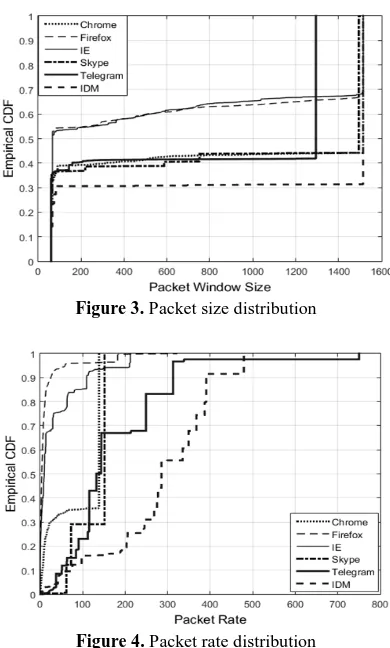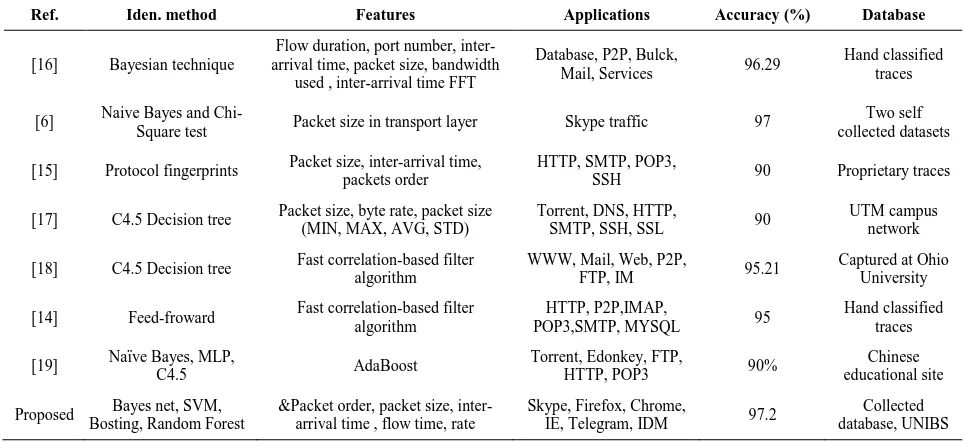Please cite this article as: M. Gandomi, H. Hassanpour, Behavioral Analysis of Traffic Flow for An Effective Network Traffic Identification, International Journal of Engineering (IJE), TRANSACTIONS B: Applications Vol. 30, No. 11, (November 2017) 1740-1745
International Journal of Engineering
J o u r n a l H o m e p a g e : w w w . i j e . i rBehavioral Analysis of Traffic Flow for an Effective Network Traffic Identification
M. Gandomi, H. Hassanpour*
Department of Computer Engineering and IT at Shahrood University of Technology , Iran
P A P E R I N F O
Paper history:
Received 20 July 2017
Received in revised form 27 August 2017 Accepted 08 September 2017
Keywords:
Network Traffic Identification Behavioral Analysis Data Mining Machine Learning Flow Statistical Featur
A B S T R A C T
Fast and accurate network traffic identification is becoming essential for network management, high quality of service control and early detection of network traffic abnormalities. Techniques based on statistical features of packet flows have recently become popular for network classification due to the limitations of traditional port and payload based methods. In this paper, we propose a method to identify network traffics. In this method, for cleaning and preparing data, we perform effective preprocessing approach. Then effective features are extracted using the behavioral analysis of application. Using the effective preprocessing and feature extraction techniques, this method can effectively and accurately identify network traffics. For this purpose, two network traffic databases namely UNIBS and the collected database on router are analyzed. In order to evaluate the results, the accuracy of network traffic identification using proposed method is analyzed using machine learning techniques. Experimental results show that the proposed method obtains an accuracy of 97% in network traffic identification.
doi: 10.5829/ije.2017.30.11b.15
1. INTRODUCTION1
There are huge amount of network traffics from various applications exchanged over the internet. In dealing with this volume of network traffic, network management is very important. Traffic classification is a basic technique which is used by internet service providers to manage network resources and guarantee internet security. In addition, growing bandwidth usage, at one hand, and limited physical capacity of communication lines, at the other hand, lead providers to improve utilization quality of network resources. In fact, classification or identification of network is a critical task in network processing for traffic management, anomaly detection and also to improve network quality-of-service (QoS) [11].
Port and payload based methods are two classical techniques which are effective under traditional network conditions [1-6]. However, many internet applications use dynamic port numbers for communications, which leads to difficulty of identifying traffic by port numbers [7]. Also many applications encrypt the transmitting
*Corresponding Author’s Email: h.hassanpour@shahroodut.ac.ir(H. Hassanpour)
data to avoid being detected [8]. Therefore, payload-based techniques become inefficient for these traffics. In recent years, traffic flow statistical feature-based identification methods (TFSIM) have attracted the interest of many researchers. The most important part of a TFSIM is the selection of efficient statistical features [2].
In this paper, we propose an effective and applicable network traffic identification method. Thus, preprocessing is performed to remove noise, the incomplete flows and the discovery of sessions before networh traffic identification. Also a robust feature extraction method using behavioral analysis of applications is applied to extract statistical features from packets. For this purpose, two network traffic databases namely UNIBS and our collected database on routers are analyzed. These databases consist of several applications such as Skype, Telegram, Firefox, Chrome, Safari, Internet Explorer, Download Manager, Thunderbird, Bittorrent and Mail.
analyzed using four algorithms, i.e. Support Vector Machine (SVM), Bayesian Network, Bosting and Random Forest.
The remainder of the paper is organized as follows, Section 2 reviews the literature about the network traffic identification methods, Section 3 discusses about the proposed method, Section 4 deals with standard UNIBS database and evaluates the results of network traffics identification and Section 5 concludes the paper.
2. RELATED WORKS
The literature in network traffic identification using statistical features can be divided into two groups, those offering one or more features to differentiate between different application traffics, and those employing machine learning techniques to identify the applications. A classification method based on Markov model with convergence criteria of Kullback-Leibler (a similarity measure for probability distributions) has been proposed by Kim et al. [9] to overcome traffic overlapping. This paper argues that the suggested method is effective for those application traffics that have much overlapping, whilst prior methods are not efficient in their classification. The accuracy of the method on 100 samples was reported as 90%. In this method a supervised learning has been used and a Markov model is constructed using the states defined via the first four packets based on the flow direction and packet size.
Muehlstein et al. [10] have shown that an attacker can determine the operating system type, browser type and application type of HTTP data and encrypted data of HTTPS using network traffic. The authors claimed, their work is the first contribution to identifying operation system, browser and application in an encrypted network. They evaluated a database containing 20 thousand sessions Windows operating system traffic, Ubuntu, Iphone operating system (IOS), Chrome Explorer, Firefox and Safari, applications such as You tube, Face book, Twitter, etc. Each session including a quintuple (source and destination port number, source and destination address, related protocol) is mapped to a triad (operating system, explorer and application) and uses the Support Vector Machine (SVM) learning algorithm and the Radial Basis Function (RBF) as the Kernel function to identify operating system type, browser type and application type.
Loo et al. [11] have proposed an algorithm based on incremental K-means clustering that uses both labeled and unlabeled samples for learning. In this method, both Manhattan and Euclidean distance metrics were evaluated to measure similarity degree of samples. The test was conducted on 671 thousand flows, and accuracy of clustering was reported to be 94%. Execution speed
using Manhattan distance metric was three times better than Euclidean.
Qin et al. [12] have suggested a model named
Bi-flow, which can capture mutual behavioral
characteristics among various terminals. Packets (out and in) with the same source and destination are regarded as Bi-flow. Packet size distribution existing in Bi-flow was used as a feature. It was shown that packet size distributions vary in different applications.
The method proposed by Aliakbarian et al. [13] seeks the best number of features for traffic identification using supervised machine learning algorithm. For classification purposes, algorithms such as decision tree, Artificial Neural Network, Bayes learning and Bagging and Boosting were used. The authors concluded that in the case of $M$ classes of applications, features space in best is reduced to M-1.
Zhou et al. [14] have suggested a method to classify network using Feed-Forward neural networks, which uses an extraction algorithm based on most similarities to choose appropriate features.
3. THE PROPOSED STATISTICAL TRAFFIC IDENTIFICATION FRAMEWORK
Consider three users, named A, B and C, are connected to the Internet (Figure 1) and the destination reaches their information through the routers. Traffic analyst is located on the router connection, and began recording the data connection. The proposed network traffic identification method is modeled in Figure 2. This model, same as supervised classification methods has both learning and testing phases. In the learning phase, labeled application packets are recorded and preprocessing operation is performed on the packets. Then statistical features is extracted and the machine learning algorithm is trained using labeled samples. In the testing phase, unknown packets are sniffed and after preprocessing and feature extraction, the trained system predicts their labels.
Figure 2. Porposed framework model
In this paper, to identify the applications using four different classification techniques, i.e. SVM, Bayesian Network, Bosting and Random Forest the results are evaluated and the best techniques are selected.
3. 1. Data Preparing In recording packets, waste
packets are one of the most important problems. The order of the waste packets is operating systems packets, firewalls packets and network components packets. Each of the mentioned items, to inform and synchronize with each other, send control packets over the network periodically. Also, redundant packets are another example of waste packets. These packets arise in case of incomplete sending or not successfully reaching at destinations. Thus, sometimes a packet is sent repeatedly. As a result, we need to apply some filters on packet capturing.
In this paper, four preprocessing steps are considered as follows: 1) removing all operating systems packets, firewalls packets and network components packets, 2) removing redundant packets (repeated packets), 3) removing unnecessary parts of packets and 4) removing incomplete flows and sessions (this part of preprocessing is performed after sessions identification).
3. 2. Pre-processing Network traffic has different
levels. To communication between a source and destination, a session is established. A session may be established in a long time, hence it is divided into flows with short intervals. Flow duration is considered to be 30 minutes [12]. The initial packets of each session have valuable information for identifation methods. For this reason, before network traffic identifocation operation, flows and sessions should be identified. As reported [15], after the flow sepration, first packet size distributions are compared, then second packet size distributions and so forth. Packets that have same Ip address and port number of the sender and recipient are considered as a session.
3. 3. Feature Selection Traffics of network
applications are divided into P2P and web application traffic (Client-Server). P2P has a distributed application
architecture that partitions tasks or workloads between peers. Peers are equally privileged, equipotent participants in the application. The Client-Server is a distributed application architecture that partitions tasks or workloads between providers of a resource or service, called servers, and service requesters, called clients. Often clients and servers communicate over a computer network on separate hardware, but both client and server may reside in the same system.
In the method of identification based on statistical features, packets content (above transport layer) is not considered. So, application's behavior is examined with regard to network layer characteristics. Table 1 presents a comparison between behavioral characteristics of P2P and Client-Server application traffics in the collected database that will be introduced in Section 4.
As seen, with regard to the behavioral analysis of applications, five statistical features were selected, i.e. packet order, packet size, time interval between send and receive of packets, time duration of flows, and packet rate in network layer. Figures 3 and 4 show the packet size and packet rate distribution.
4.EXPERIMENTAL RESULTS
In previous section, five statistical features were selected with respect to behavioral analysis of the applications. In this section, at first, two databases of UNIBS and our collected database are examined. Having evaluated the features using machine learning algorithms, the features are examined in identification of six applications.
4. 1. UNIBS Database These data were collected
from the router inside Bersica University.
TABLE 1. Behavioral features of Client-Server and P2P
applications
Characteristics Traffic (P2P) Traffic (Client-Server)
Bite transmission
rate in flows High Low
Self-similarity
property parameter <0.5 0.7-0.8
Data distribution Heavy trail, on/off Long tail
Flow duration <100 milsec >100 milsec
Data transmission
rate bit/sec Low High
Time interval between packet send and receive
<0.3 milsec >0.3 milsec
Packet size >800 byte <800 byte
Entropy High Low
Packet
Transmission rate <3*10
Figure 3. Packet size distribution
Figure 4. Packet rate distribution
Ethernet of the university includes several 1000Base-TX (one of the most prevalent and fastest forms of old Ethernet so far) and the routing was carried out by two-core Linux processors. Data have been collected from link 100Mb/s in router with the help of Tcpdump software.
The data were collected in a two days period in rush hours. Since there was full access to the router, 250 bites of each frame were saved. Labeling the data was performed using ground truth algorithm and by examining packet content. For this reason, labels for applications were provided with a high reliability. Table 2 shows the number of samples containing six applications from this database.
4. 2. The Collected Database This data was
collected from a local area network router.
TABLE 2. UNBS database
Application Count of samples
Firefox 3516410
Thunderbird 65660
Skype 181550
Safari 3482650
Bittorrent 1244240
Mail 1007790
The data have been collected from link 1gb/s in router using the Wireshark software; traffic of six applications have been captured. The data were collected in a three days period in rush hours. Data labeling was performed using Deep Packet Inspection (DPI) method and by examining packet content. Hence, labels of applications were provided with a high reliability. Table 3 shows the number of samples containing six applications from this database.
4. 3. Identification Results In this section, we use
the selected features from the previous section, and identify the related applications using four different classification techniques, i.e. SVM, Bayesian Network, Bosting and Random Forest.
Tables 4 and 5 show the accuracy of the four different machine learning algorithms on two databases in application identification. The number of samples in the applications are different, so each of the applications is evaluated individually. Table 6 compares the results of using the selected features from the existing approaches. As can be seen, results of the selected features using the proposed approach have a higher detection rate compared to other methods.
TABLE 3. Collected database
Application Count of samples on router
Firefox 636070
Skype 302130
Telegram 681760
IDM 529580
Chrome 302610
IE 305030
TABLE 4. Results from UNIBS database
Application RandForest Bosting SVM BayesNet
Firefox 89.90 52.96 26.56 96.17
Thunderbird 93.09 61.77 54.41 93.07
Skype 88.97 59.20 59.43 98.78
Safari 85.11 49.83 66.93 96.18
Bittorrent 97.70 68.11 46.63 89.22
Mail 95.97 49.80 39.97 96.98
TABLE 5. Results from collected database
Application RandForest Bosting SVM BayesNet
Firefox 96.1 34.41 91.77 93.09
Skype 97 36.56 62.96 74.30
Telegram 97.18 39.83 41.39 77.24
IDM 95.32 50.15 14.25 97.47
Chrome 95.88 26.43 29.20 88.47
TABLE 6. Comparison results between the proposed method and other existing methods
Ref. Iden. method Features Applications Accuracy (%) Database
[16] Bayesian technique
Flow duration, port number, inter-arrival time, packet size, bandwidth
used , inter-arrival time FFT
Database, P2P, Bulck,
Mail, Services 96.29
Hand classified traces
[6] Naive Bayes and
Chi-Square test Packet size in transport layer Skype traffic 97
Two self collected datasets
[15] Protocol fingerprints Packet size, inter-arrival time, packets order
HTTP, SMTP, POP3,
SSH 90 Proprietary traces
[17] C4.5 Decision tree Packet size, byte rate, packet size (MIN, MAX, AVG, STD)
Torrent, DNS, HTTP,
SMTP, SSH, SSL 90
UTM campus network
[18] C4.5 Decision tree Fast correlation-based filter algorithm
WWW, Mail, Web, P2P,
FTP, IM 95.21
Captured at Ohio University
[14] Feed-froward Fast correlation-based filter algorithm
HTTP, P2P,IMAP,
POP3,SMTP, MYSQL 95
Hand classified traces
[19] Naïve Bayes, MLP, C4.5 AdaBoost Torrent, Edonkey, FTP, HTTP, POP3 90% educational site Chinese
Proposed Bayes net, SVM, Bosting, Random Forest
&Packet order, packet size, inter-arrival time , flow time, rate
Skype, Firefox, Chrome,
IE, Telegram, IDM 97.2
Collected database, UNIBS
5. CONCLUSION
In this paper, we proposed an effective network traffic identification method. In this method, initially preprocessing is performed to remove noise, the incomplete flows and the discovery of sessions before identification. Then feature extraction is performed using behaviral analysis of applications. Two network traffic databases namely UNIBS and our collected database on routers were analyzed. Following the behavioral analysis of the applications, flow statistical features were selected. These features are packet order, packet size, time interval between packet send and receive, time duration of flows, and packet forwarding rate. To evaluate the results, the accuracy of application identification method by four algorithms, namely Bosting, SVM, Bayesian Network and Random Forest was analyzed. The evaluation results show a high identification accuracy on the two database containing different versions of applications.
REFERENCES
1. Foremski, P., "On different ways to classify internet traffic: A short review of selected publications", Theoretical and Applied
Informatics, Vol. 25, (2013), 147–164.
2. Zhang, J., Xiang, Y., Wang, Y., Zhou, W., Xiang, Y. and Guan, Y., "Network traffic classification using correlation information", IEEE Transactions on Parallel and Distributed
Systems, Vol. 24, No. 1, (2013), 104-117.
3. Wang, Y., Xiang, Y. and Zhang, J., "Network traffic clustering using random forest proximities", in Communications (ICC), IEEE International Conference on, IEEE., (2013), 2058-2062.
4. Adami, D., Callegari, C., Giordano, S., Pagano, M. and Pepe, T., "Skype‐hunter: A real‐time system for the detection and classification of skype traffic", International Journal of
Communication Systems, Vol. 25, No. 3, (2012), 386-403.
5. Finamore, A., Mellia, M., Meo, M. and Rossi, D., "Kiss: Stochastic packet inspection classifier for udp traffic",
IEEE/ACM Transactions on Networking, Vol. 18, No. 5,
(2010), 1505-1515.
6. Bonfiglio, D., Mellia, M., Meo, M., Rossi, D. and Tofanelli, P., "Revealing skype traffic: When randomness plays with you", in ACM SIGCOMM Computer Communication Review, ACM. Vol. 37, (2007), 37-48.
7. Kotsiantis, S.B., Zaharakis, I. and Pintelas, P., Supervised
machine learning: A review of classification techniques. 2007.
8. AbuHmed, T., Mohaisen, A. and Nyang, D., "A survey on deep packet inspection for intrusion detection systems", arXiv
preprint arXiv:0803.0037, (2008).
9. Kim, J., Hwang, J. and Kim, K., "High-performance internet traffic classification using a markov model and kullback-leibler divergence", Mobile Information Systems, Vol. 2016, (2016).
10. Muehlstein, J., Zion, Y., Bahumi, M., Kirshenboim, I., Dubin, R., Dvir, A. and Pele, O., "Analyzing https encrypted traffic to identify user's operating system, browser and application", in Consumer Communications & Networking Conference (CCNC), 2017 14th IEEE Annual, IEEE., (2017), 1-6.
11. Loo, H.R. and Marsono, M.N., "Online network traffic classification with incremental learning", Evolving Systems, Vol. 7, No. 2, (2016), 129-143.
12. Qin, T., Wang, L., Liu, Z. and Guan, X., "Robust application identification methods for p2p and voip traffic classification in backbone networks", Knowledge-Based Systems, Vol. 82, (2015), 152-162.
14. Zhou, W., Dong, L., Bic, L., Zhou, M. and Chen, L., "Internet traffic classification using feed-forward neural network", in Computational Problem-Solving (ICCP), 2011 International Conference on, IEEE., (2011), 641-646.
15. Crotti, M., Dusi, M., Gringoli, F. and Salgarelli, L., "Traffic classification through simple statistical fingerprinting", ACM
SIGCOMM Computer Communication Review, Vol. 37, No. 1,
(2007), 5-16.
16. Moore, A.W. and Zuev, D., "Internet traffic classification using bayesian analysis techniques", in ACM SIGMETRICS Performance Evaluation Review, ACM. Vol. 33, (2005), 50-60.
17. Zhang, J., Chen, C., Xiang, Y., Zhou, W. and Xiang, Y., "Internet traffic classification by aggregating correlated naive bayes predictions", IEEE Transactions on Information
Forensics and Security, Vol. 8, No. 1, (2013), 5-15.
18. Hu, L. and Zhang, L., "Real-time internet traffic identification based on decision tree", in World Automation Congress (WAC), 2012, IEEE., (2012), 1-3.
19. Wang, Y., Xiang, Y. and Yu, S., "Internet traffic classification using machine learning: A token-based approach", in Computational Science and Engineering (CSE), 2011 IEEE 14th International Conference on, IEEE., (2011), 285-289.
Behavioral Analysis of Traffic Flow for an Effective Network Traffic Identification
M. Gandomia, H. Hassanpourb
a Artificial Intelligence, Shahrood University of Technology, Shahrood, Iran
b Department of Computer Engineering and IT at Shahrood University of Technology , Iran
P A P E R I N F O
Paper history:
Received 20 July 2017
Received in revised form 27 August 2017 Accepted 08 September 2017
Keywords:
Network Traffic Identification Behavioral Analysis Data Mining Machine Learning Flow Statistical Featur
ديكچ ه
همانرب هعسوت و شیازفا اب هزورما تهج هکبش کیفارت تقد اب و عیرس یدنب هقبط و ییاسانش ،هکبش تحت یدربراک یاه
و یهد سیورس تیفیک ندربلااب شور نونکات .دشاب یم هکبش ناریدم مربم زاین ،اه یراجنهان ییاسانش
تهج یددعتم یاه
.تسا هدش هئارا هکبش کیفارت ییاسانش شور نایم نیا رد
هتسب یرامآ لیلحت رب ینتبم یاه شور کمک هب اه
یریگدای یاه
یم ییلااب تیمها یاراد ،نیشام دنشاب
. شور نیا رد .تسا هدش هئارا هکبش کیفارت ییاسانش تهج یشور هلاقم نیا رد
هداد یزاس هدامآ تهج کی زا اه
هار شیپ لح سپس .تسا هدش هدافتسا رثوم شزادرپ یگژیو
زا هدافتسا اب اه هتسب یاه
همانرب راتفر لیلحت هتسب تفایرد و لاسرا ،تخاس رد یدربراک یاه
هدش جارختسا ناربراک اب لماعت تهج اه رما نیا لیلد .دنا
یم ار همانرب ییارجا مسیناکم و راتفر رییغت مدع ناوت رد یدربراک یاه
هخسن راتفر ادتبا روظنم نیمه هب .تسناد فلتخم یاه
همانرب شش رارق یبایزرا و یسررب دروم دولناد تیریدم و مارگلت ،ررولپسکا تنرتنیا ،مورک ،سکافریاف ،پیاکسا یدربراک
همانرب نیا راتفر هب هجوت اب و هتفرگ یگژیو یدربراک یاه
.تسا هدش جارختسا ییاه یاه یگژیو یبایزرا یارب
،هدش هئارا
هداد هداد هاگیاپ ود یاه
UNIBS
و ،بایریسم یور رب هدش یروآ عمج هداد هاگیاپ دروم
هدافتسا و لیلحت هتفرگ رارق .تسا
جیاتن یبایزرا تهج ،
یدربراک همانرب تسرد صیخشت تحص نازیم نیشام یریگدای یاه متیروگلا طسوت
رارق لیلحت دروم
یم یم ناشن جیاتن .دریگ هک دهد
هدش هئارا شور نرازیم
زا شیب هب ار یدربراک یاه همانرب ییاسانش تقد 97
یم شیازفا %
-.دهد



